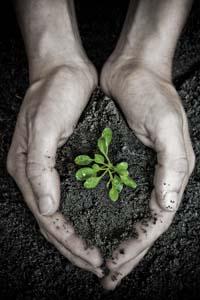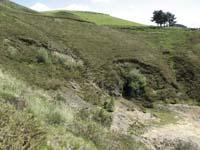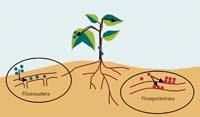Will it be cured, a doctor of soil?
Disease Disease Disease

Soil is one of our most important resources, since it provides the environment and the human being with different ecosystem services. Participates in the regulation of biogeochemical cycles, bioremediation of contaminants, supply of food and fuels, regulation of atmospheric gases, control of pests and potential pathogens, game, spiritual use, etc. Although our well-being depends on these ecosystem services, unfortunately they are not properly recognized in the management policies of the economic market and the environment.
Diagnostic Diagnosis and Diagnosis

As a pathology, given the symptoms of a possible "disease" of the edaphic ecosystem, the first step would be to identify the cause of the disease. Biological parameters have been proposed as bioindicators of the health of the soil ecosystem: microbial biomass, mineralizable nitrogen, soil enzymatic activities, root pathogens, growth and plant diversity, etc. Of all these, the microbial parameters, especially those related to biomass, activity and biodiversity of microbial communities, have a great potential as bioindicators, with a high sensitivity, a rapid response capacity to alterations and an integrative character. In fact, microorganisms are important actors in the execution of soil functions, since they are responsible for 70-85% of the biological activity. To give an example of the enormous diversity of microorganisms present in the soil, in a handful can be found 100 billion bacteria of 10,000 species or 50 km of fungi of more than 500 species.
Therapy therapy therapy therapy
When the disease has been "diagnosed" from symptoms and measurements, a "therapy" can be applied. At the same time, a program of monitoring the evolution of the disease should be established that allows to know the efficacy of the treatment (using as bioindicator the microbiological properties of the soil). In recent years, the development of innovative biological technologies has been promoted that allow to remedy at low cost the soils contaminated with metals. For example, in the 1980s, the possibility of using plants that can extract metals from contaminated soils was proposed. The use of plants to remove or attenuate contaminants from the medium is called phytoremediation. Within the phytoremediate there are several categories:

In phytoextraction plants are used to extract contaminants from the soil. The continuous phytoremedy consists of the use of hyperaccumulative metal plants capable of supporting high amounts of metals during the entire crop cycle. One of the best known species of this type of species is Thlaspi caerulescens. In the Basque Country there is also a variety of this unique plant (known as Lanestosa) that can accumulate in leaves and stems up to 2.5% zinc and 0.02% cadmium.
Unfortunately, most of the hyperaccumulative plants (including T. caerulescens) are of slow and small growth, and in addition they do not have a regulated agrarian practice. Other plants, for their part, have a lower accumulation of metals, but compensate it with a higher growth rate. For this reason, high biomass crops are increasingly investigated for use in phytoextraction. Perhaps it is the strategy that combines phytoremediation with obtaining products that provide a long-term added value, with the future more promising commercially. For example, sorghum can be used as an energy culture for bioethanol production. The discussion between current food vs biofuel could be avoided if contaminated soils (not suitable for food growth) were used for the production of energy biomass.
On the other hand, there are low accessibility metals for plants such as lead. In these cases it was discovered that the addition of chelating agents to the soil increased the absorption of the plants, thus opening a new door of investigation, that of "phytoextraction with chelating". Chelating agents are substances that together with metals form complexes and that when incorporated into the soil they can increase the availability of metals. However, we must take into account the effects that chelants themselves can have on the health of the soil. The most commonly used chelator so far is EDTA (ethylene diamintetraacetic acid). Unfortunately, the complex that forms the lead EDTA presents a low rate of biodegradation and a high solubility, which means a high risk of leaching before the absorption of the plants. In recent times, however, the use of natural chelators such as EDDS (ethylene diamine-N,N´-disuccinic acid) has been proposed, which are easily biodegradable and generate less leaching.

Although phytoextraction is a promising technology, the current degree of development requires longer periods than other remediation techniques to carry out the process. Especially in soils with high levels of pollution, as in a mine, a more realistic alternative is the so-called phytostabilization. Phytostabilization seeks the immobilization of the contaminant, either accumulating it in the roots of the plant, or precipitating it in the root medium. In this way, the contaminant remains in the soil, but migration by erosion and leaching is avoided. Furthermore, phytostabilization can be combined with organic amendments. These amendments improve soil properties through the retention of excessive metals and the supply of nutrients to plants. It is of great interest, in turn, the use as organic amendments of residues ( e.g., cow purines) for the value of plants, provided they do not suppose a damage to the health of the soil.
So things, it seems that the most adequate remediation strategy will depend on local circumstances. We must take into account the future use of this soil, the type and degree of pollution, etc. In any case, it should be noted that the maximum objective of any process of phytoremediation should be not only the removal of the contaminant, but also the recovery of the health of the soil, that is, the recovery of the capacity of this resource to perform functions in a sustainable way.
Healing healing Healing Healing Healing

Finally, it is necessary to establish reference values for the parameters used in monitoring the development of the disease to determine whether or not the soil has recovered its health. Unfortunately, the edaphic ecosystem is extremely complex and heterogeneous in space/time and it is difficult to determine the healthy state of a soil.
Finally, it is known that medicine has allowed throughout history to deepen the knowledge of the physiology of the human body. Also of great interest is the study of contaminated soils to try to understand the functioning of the edaphic ecosystem so far unknown.
Thanks to the BERRILUR Consortium for helping you play the floor doctor in your doctoral thesis.

BIBLIOGRAPHY BIBLIOGRAPHY
Buletina
Bidali zure helbide elektronikoa eta jaso asteroko buletina zure sarrera-ontzian











